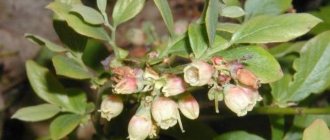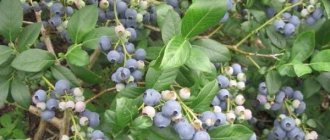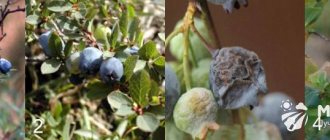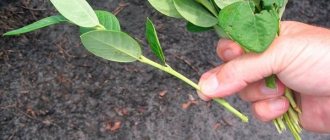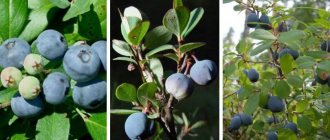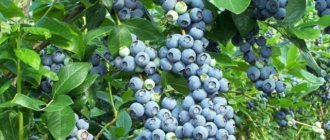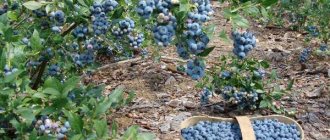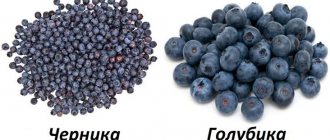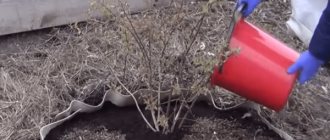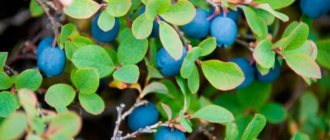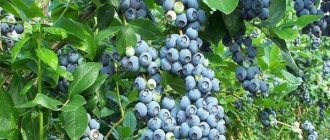Description of the berry crop
The hybrid amazes with its abundant harvest of fruits, so it quickly spreads in regions with a short warm season.
General idea of the variety
The shrub rises only 60-90 cm. The blueberry root system is fibrous, densely branched, and located in the upper soil layer. A hybrid of medium vigor, produces up to 5 young shoots per season. Straight, powerful skeletal branches radiate to the sides, forming a spreading crown, which in circumference is approximately equal to the height. The annual growth of North Blue blueberries is from 30 cm, green in color with a matte effect. Old branches are light brown. The leaves are ovate, pointed, glossy on the upper side of the blade, 4-6 cm long. On the side branches of blueberry bushes, flower panicles are formed, 6-10 white-cream flowers of a beautiful bell-shaped shape.
Berries
In the clusters the fruits are collected in a heap. North Blue highbush blueberries have large berries with a small ridge. The fruits are from 15 to 18 mm wide, weighing up to 2.5 g. The pulp of North Blue fruits has a dense structure, attractive taste, aromatic, sweet, without cloying, with a slight sourness. Tasters gave them the highest rating.
A special feature of the berries of the North Blue hybrid is the high content of pigments of the glycoside group - anthocyanins. Under their influence, the durable skin of the berries acquires a rich shade of ultramarine, with a waxy coating on top. 100 g of dry North Blue berries contain 6.73 g of anthocyanins, which exceeds the characteristics of other blueberry varieties by 2-3 times. These are not just coloring substances, they are active antioxidants.
Important! Anthocyanins give berries their bright dark blue color and provide them with healing properties.
Northblue, or blueberry goes north
Breeding work was carried out within the framework of the blueberry breeding program of the US Department of Agriculture, in 1973 it was selected from hybrid seedlings obtained in 1967 from seedlings of the descendants of the cross G-65 and Asworth (V.Corymbosum), paternal line US-3.
Included in the State Register of Varieties of Belarus. Recommended for regions where tall varieties show low productivity due to poor frost resistance. Good as a container crop for the winter garden.
Northblue is the most winter-hardy among varieties of this type, including Northcountry, Northland, etc. It is used fresh, for freezing, and processing. It is not particularly widespread in industrial cultivation due to its relatively low yield; it is valued in gardening and in small areas.
Description of Northblue blueberries
Ideal for the north of the Republic of Belarus and the east, central part, central part of Russia, Ukraine. Like all plants of this type, it spreads much further north than the tall-growing varieties. It has a short growing season, high frost resistance, and small fruits.
The photo shows Northblue blueberries - ripe berries in a cluster and ripening
- Semi-tall type, medium-tall - this is what it is often called, translated from English as half-height.
- The fruits are large - up to 15-18 mm, dark blue, rich deep color, with a small scar. Tasty, aromatic, with dense pulp - just begging to be picked up. Ripens in late July - early August. The period from flowering to the beginning of Northblue ripening is 47-63 days.
- Frost resistance according to American data is up to -40 C, according to Polish sources up to -37, according to Belarusian sources up to -35 C - requires shelter in the northern regions, in regions north of the Moscow region, in the north-east of Ukraine in snowless winters it is also worth taking care of at least mulching the bottom of the trunk.
The peculiarity of the Northblue blueberry variety is not even its relatively good winter hardiness, yield and fruit size: compact bushes, by and large, bring about the same amount as many other varieties. Anthocyanins are the same ones that color the berries blue, blue, and gray. from a record high – 6.73 g per 100 g of dry berries. For comparison, the same Patriot is 2.46, Darroy is 3.3, Bluecrop is 1.15!
Care and cultivation, planting, fertilizing: briefly about the main thing
When purchasing, straighten the bunched roots - the container often forms a real ball. When planting, the roots should be directed horizontally. After transplanting to a permanent location, they should grow freely.
The landing nest is at least 1 m in diameter. Since the fibrous, densely branched roots of the crop are located in the upper layer of soil, the depth of the holes is up to 50-60 cm. The distance when planting Northblue is between rows from 2-2.5 to 3, in a row up to 2 m. After planting the seedlings above 40-45 cm, they are cut off by 1/4.
In the first year, the ovary is not allowed to form: wood is built up. Full pruning begins at the 3rd year.
To establish strong skeletal branches, I cut the growth to a height of 35-40 cm. In the spring, thin, diseased, weak shoots near the root collar are eliminated. After 5-6 years, anti-aging pruning is needed.
These are the basics of growing the Northblue blueberry variety - briefly about the most important points of care: what is important to know.
- Prone to overload - the next year after abundant fruiting, the number of flower buds is normalized by pruning. The fruits will be smaller, the size will be quite large.
- Does not like overfeeding: excess mineral fertilizers have a detrimental effect on the development of mycorrhiza - it inhibits the development of the fungus, resulting in diseases of the root system, suppressed growth, and decreased yield. This is true for all varieties. Excess fertilizing with inadequate watering is especially destructive.
- Acid forms of the NPK complex are used: superphosphate, potassium sulfate, ammonium sulfate. Approximate amount – for a 2-year-old plant – 1 tbsp. mineral fertilizer, for 3 years - 2 tbsp, 4 - 4 tbsp. Fertilizers are applied in three stages: 50% of nitrogen occurs at the time of bud break, 25% is applied in early May and early June, during the phase of fruit formation and ripening. The amount of fertilizer applied is based on the condition of the plants - at a minimum, and as a maximum, which would be the norm - based on their soil analysis.
They also bring in organic matter - don’t rush to protest. In the usual sense, this is fresh manure, bird droppings. They are absolutely not allowed.
And here is a little humus, rotted sawdust, bark, forest litter. This includes preserving moisture in the tree trunk, preserving the looseness of the soil and its acidification, and protecting it from weeds.
But the main thing is the organogenic substrate - food for the mycorrhizal fungus.
As for propagation - by cuttings, it produces root shoots (according to Kurilovich, it is propagated by semi- and lignified cuttings).
You should not overestimate the frost resistance of plants: even well-mulched, they will not be able to tolerate temperatures below - 35...-40 C: they will freeze above the snow level.
Varieties of this group are grown in Finland, Kaluga, and the Urals - but provided that the lower part of the stems is protected from frost and partially covered.
Young plants can be bent, tied, pinned, then covered with vegetable mulch or according to the principle of grapes, improvised materials, or agrofibre. Mature tall bushes are tied and attached to stakes so that they do not break due to snow and infusion - everyone has their own technique.
If it is possible to organize shelter in small quantities - on the principle of sheltering grapes and blackberries for the winter - then this technique will not work on industrial plantings. Despite the declared frost resistance, in the northwestern regions of Russia, the northeast of Ukraine, and the north of Belarus, growing Northblue in large volumes is a risky undertaking.
Otherwise, the blueberry variety Northblue received good reviews: in addition to the disadvantages, the low yield in comparison with tall species is compensated by the compact habit of the plants, their vitality and unpretentiousness. This is an excellent choice for the garden, winter garden, and for growing in containers. Many are attracted by the high anthocyanin content - indeed, this is a real record holder, and not only in comparison with blueberries.
As for yield, as mentioned above, a 5-6 year old plant will produce a maximum of 2.5 kg - up to 3 in the hands of professionals. Considering that compact plants take up little space per m2, these are not the lowest results.
It is worth considering that this is one of two varieties included in the State Register of Belarus - this indicates high quality fruits and stable yields.
Whether a blue berry will take root on your site depends not only on the climate: give it competent care, care and the warmth of its owner’s hands - it will respond with generous clusters of blue, aromatic berries. Have a generous harvest!
Source: https://vizazh-2.ru/sorta-golubiki/nortblyu-ili-golubika-idet-na-sever/
Characteristic
The compact North Blue bush is popular for its unpretentiousness and sufficient decorativeness.
Main advantages
The variety is grown in regions where tall blueberries freeze slightly. The shrub can withstand temperatures down to -35 °C. Frost resistance decreases in snowless winters. At the same time, the hybrid, created on the basis of low-growing species, is moderately resistant to drought and can withstand short-term drying out of the soil. In hot summers, plants are watered. According to reviews of North Blue blueberries, the plant develops well in acidic light soils and is undemanding in care. Ripe berries are stored for 10 days, they have a dry detachment from the stalk, and are suitable for transportation.
Flowering period and ripening time
North Blue blueberry buds bloom in late May, flowering lasts up to 20 days. The ovaries mature within two months. The fruits are harvested from late June or early August to September. The ripening of blueberries is affected by spring frosts, air temperature, soil moisture and the presence of mineral fertilizers.
Yield indicators, fruiting dates
Descriptions of the North Blue blueberry mention its self-fertility, but many gardeners still advise planting several bushes of the crop nearby. Due to cross-pollination, the yield increases significantly, and a lonely bush produces only a third of the berries from the total number of flowers. In addition, observations show that the fruits on plants surrounded by neighboring blueberry bushes are sweeter and more tender. North Blue bears fruit consistently every year; from 1.2 to 2.5 kg of berries are collected from the bush per season.
Signal berries are formed under good conditions and in the first season after planting. Experienced gardeners recommend giving blueberries the opportunity to grow wood and break off the ovaries. The bush begins to bear fruit in the 2-3rd year.
Comment! The bush is prone to harvest overload. After abundant fruiting the next year, some of the flower buds are cut off to make the berries larger.
Area of application of berries
Blueberries are useful fresh or in the form of fresh juice. The berries are made into jam, compotes, and frozen. Used as a fragrant filling in pies.
Resistance to diseases and pests
According to the characteristics of the variety, North Blue blueberries are not susceptible to diseases such as anthracnose, moniliosis, white spot, and gray rot that affect berry bushes. The plant is protected from aphids, various caterpillars and mites, and beetle larvae.
Advantages and disadvantages of the variety
The obvious advantages of the shrub contribute to its spread:
- frost resistance;
- high consumer qualities of fruits;
- productivity of a relatively compact bush shape;
- decorativeness of the plant.
The requirement for a sunny planting location is considered a disadvantage of the variety.
Blueberries in winter
The description of the behavior of blueberries in winter comes down to the following: in winter, Nord blue blueberries can withstand the most severe frosts, but if there is a lack of snow, the bushes can become icy and freeze. To avoid this, you should tie the bushes with spruce branches for the winter or cover them with suitable material other than polyethylene. At the time of flowering, this berry can easily tolerate temperatures down to -7°C, so in spring blueberries practically do not need protection.
Blueberries are a healthy and tasty berry. It can make delicious jam, it can be added to porridge, or consumed with milk. The number of blueberry recipes is endless. The Nordblue variety is the most frost-resistant and one of the most fruitful. The Nord Blue variety is resistant to various weather changes and is easy to care for. Proper care of this berry throughout the year will provide a good harvest and the opportunity to enjoy a dessert made from natural fresh berries. The Nord Blue variety is distinguished by its taste. It is sweeter than others, but does not leave a cloying aftertaste.
Landing rules
The hybrid will grow well and produce a bountiful harvest if planting rules are followed.
Attention! An interval of 1-1.5 m is left between the North Blue blueberry bushes.
Recommended timing
Spring is the best time to move blueberries into the garden. Plants in containers are also planted later, at the beginning of summer. In warm climates, North Blue blueberries can be planted in the fall, with a long interval until frost sets in to allow the bush to become established.
Choosing a suitable location
Although the low shrub was bred on the basis of wild plants from wetlands, garden blueberries require completely different conditions:
- well-drained light soils, preferably peat bogs, sandy or loamy soils, and good light without partial shade will ensure the expected berry harvest;
- using testers, it is necessary to analyze the acidity of the soil in the garden - optimal pH values: 3.8-5;
- groundwater depth is not higher than 60 cm.
Soil preparation
North Blue blueberries should be planted in a carefully prepared substrate if the garden soil does not meet the requirements of the variety. A pit 70 x 70 cm wide is prepared so that a 30-50 cm layer of high-spread red peat can fit. Or prepare a substrate from 3 parts of peat, 1 - leaf, 2 - coniferous soil. 10 cm of drainage is placed at the bottom.
Selection and preparation of seedlings
The stems of a healthy North Blue shrub are elastic, the buds are alive, and the bark is without damage. If the seedling is purchased in a container, it is soaked in water for several hours before planting. The roots are straightened out, because in cramped conditions they become lumpy.
Algorithm and landing scheme
Before planting, hammer in a peg to tie up the stem:
- the prepared seedling is deepened into the hole, straightening the horizontally woven roots in an earthen coma;
- the root collar is 5 cm below ground level;
- sprinkle with substrate, compact, water, mulch with pine needles or pine sawdust;
- seedlings above 40 cm are cut to 100-120 mm.
North Blue blueberries: variety description, reviews, photos
North Blue blueberry is a mid-early hybrid that produces a bountiful harvest of large and tasty berries, despite its short stature. The plant is winter-hardy, suitable for growing in harsh climatic conditions. Caring for blueberries is easy.
History of selection
The North Blue blueberry variety has been bred by breeders in the USA as part of a cultural propagation program since 1973. The parents are called seedlings US-3, G-65, Asworth. An intermediate hybrid of tall species and narrow-leaved Canadian blueberry is particularly frost-resistant.
Subsequent care of the crop
Growing North Blue blueberries requires the gardener to pay attention to pruning and mulching the tree trunk.
Necessary activities
North Blue blueberries are watered during periods without rain, 10 liters per bush every 2-3 days. The soil is moist, but without stagnant water. A variety planted in the south requires sprinkling 2 times a week or more often during hot weather. For fertilization in the spring at the beginning of flowering and the creation of ovaries, ammonium and potassium sulfates or minerals in a special complex are used.
Advice! To prevent excessive evaporation of moisture, the mulch layer is raised to 15 cm.
Shrub pruning
In early spring, sanitary and formative pruning is carried out. The latter type is used after a bountiful previous harvest to relieve the bush.
Preparing for winter
Despite the fact that the North Blue blueberry variety is frost-resistant, the bushes are covered in autumn in regions with little snow. Wrap the shoots in agrotextiles to protect them from icing. The mulch layer is raised.
Subtleties of care and ripening time
Blueberries require standard care. It needs watering, fertilizing, loosening, weeding, mulching, pruning, preventive treatments against diseases and harmful insects. The plantings should be moistened once a week.
During drought, you need to increase the amount of watering to 2-3 times a week. Watering is required during fruit formation. With a lack of moisture, the berries are formed small and take a long time to ripen. However, you should not overdo it, as too much moisture will cause the blueberries to crack.
Plants need to be watered with warm water that has been standing for several days. It is advisable to organize drip irrigation. You need to pour 10 liters of water under one bush. After watering or rain, the soil in the tree trunk zone must be loosened so that the surface layer does not become compacted and the supply of air and moisture to the roots is not hampered. Loosening should be done carefully and not too deeply, so as not to damage the root system in the surface layer. It is important to promptly remove weeds near the bushes. They take away nutrients from the fruits, block the sun, and infect them.
If it is not possible to frequently care for the plantings, then you can reduce the number of watering, loosening and weeding as follows: sprinkle the tree trunk area and row spacing with a layer of mulch made from sawdust or pine needles. This will prevent evaporation, maintain normal soil moisture levels and slow down the growth of weeds. To achieve regular and abundant fruiting, it is necessary to fertilize. It is recommended to add only mineral mixtures. Popular organic fertilizers such as manure, compost, and green manure are not suitable for feeding blueberries, as they weaken the acidity of the soil.
Only high-moor peat is suitable for organic matter.
Diseases and pests, methods of control and prevention
| Diseases | Signs | Treatment | Prevention |
| Viral red leaf spot | Red spots, small shoots and leaves | Removing the plant | Control of insects and ticks, vectors: “Karbofos”, “Fufanon” |
| Stems cancer | Brown spots, cracks and ulcers on the bark | Removing shoots | Pruning according to the rules. Spraying with Bordeaux mixture |
| Pests | Signs | Struggle | Prevention |
| Kidney mite | Galls on branches | Iron sulfate, Nitrafen | Cleaning up fallen leaves and affected shoots |
| Flower beetle | Fallen buds | "Intavir", "Fufanon" | Autumn cleaning |
